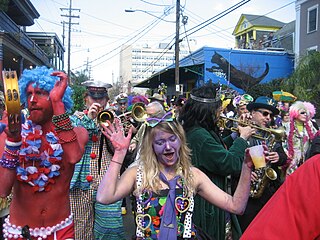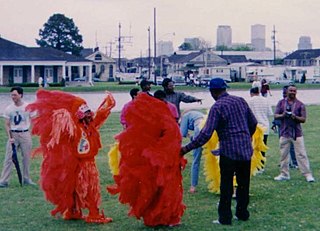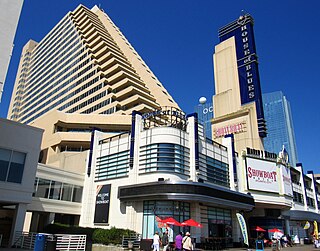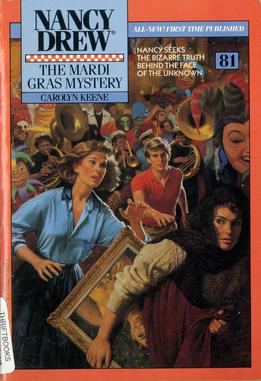
Mardi Gras refers to events of the Carnival celebration, beginning on or after the Christian feasts of the Epiphany and culminating on the day before Ash Wednesday, which is known as Shrove Tuesday. Mardi Gras is French for "Fat Tuesday", reflecting the practice of the last night of eating rich, fatty foods before the ritual Lenten sacrifices and fasting of the Lenten season.

The Mistick Krewe of Comus, founded in 1856, is the oldest, continuous, New Orleans, Louisiana, Carnival Krewe having paraded with few interruptions from 1856-1991, while continuing to hold a tableau ball for its members and guests to date.

Rex is a New Orleans Carnival Krewe which stages one of the city's most celebrated parades on Mardi Gras Day. Rex is Latin for "King", and Rex reigns as "The King of Carnival".

The holiday of Mardi Gras is celebrated in southern Louisiana, including the city of New Orleans. Celebrations are concentrated for about two weeks before and through Shrove Tuesday, the day before Ash Wednesday. Mardi Gras is French for Fat Tuesday, but the season actually begins on King's Day, January 6, and extends until midnight before Ash Wednesday. Club, or Krewe, balls start soon after, though most are extremely private, with their Kings and Queens coming from wealthy old families and their courts consisting of the season's debutantes. Most of the high society Krewes do not stage parades. As Fat Tuesday gets nearer, the parades start in earnest. Usually there is one major parade each day ; many days have several large parades. The largest and most elaborate parades take place the last five days of the Mardi Gras season. In the final week, many events occur throughout New Orleans and surrounding communities, including parades and balls.

Mardi Gras Indians are black carnival revelers in New Orleans, Louisiana, who dress up for Mardi Gras in suits influenced by Native American ceremonial apparel.
The French Quarter neighborhood of New Orleans, Louisiana is the center of the city's Carnival celebrations, especially on Mardi Gras Day. This part of town is crowded with both tourists and locals, with the former more numerous in the Upper Quarter, the latter in the Lower Quarter. There are numerous parties and more than one costume contest. While the large motorized floats of the big parades have been prohibited since the early 1970s from going down the Quarter's narrow streets, numerous small marching krewes, parading jazz bands, and groups of revelers converge here. Some krewes parade in the Quarter after starting earlier in the day in other parts of town.
The Krewe of Endymion is a New Orleans Mardi Gras super krewe and social organization.
The Half-Fast Walking Club is a New Orleans Mardi Gras krewe founded and historically led by Pete Fountain, until his passing on August 6, 2016. Originally all on foot, in recent decades it has also featured one or two small floats. Fountain and other local jazz musicians played through much of the parade. The krewe's current route, basically unchanged since the mid-1970s, starts at 7 AM on Mardi Gras morning, at world-famous Commander's Palace Restaurant on Washington Avenue in the Garden District. The krewe then proceeds downtown on St. Charles Avenue and after a brief interlude on Canal Street, enters the French Quarter at Bourbon Street, winds around the Quarter and eventually ends up at the Monteleone Hotel in the early afternoon.

Chief Allison "Tootie" Montana, a lather by trade, was a New Orleans cultural icon who acted as the Mardi Gras Indian "Chief of Chiefs" for over 50 years. Tootie is revered in the Mardi Gras Indian culture as the Big Chief. Tootie was the Big Chief of the Yellow Pocahontas Tribe and made the culture of the Mardi Gras Indians about pageantry rather than combat display.
"Big Chief" is a song composed by Earl King in the early 1960s. It became a hit in New Orleans for Professor Longhair in 1964, featuring a whistled first chorus in a rollicking blues piano style and subsequent lyrics written in mock-American-Indian pidgin. The tune became popular in New Orleans, frequently performed by local musicians such as Dr. John, and is now a staple of the repertory of most brass bands and musicians in the area.
Krewe of Boo is New Orleans' official Halloween parade krewe. The parade was created by the Mardi Gras World owner and founder Blaine Kern Sr. Krewe members must be at least 18 years of age.

Mardi Gras throws are strings of beads, doubloons, cups, or other trinkets passed out or thrown from the floats in the New Orleans Mardi Gras, the Mobile Mardi Gras and parades all throughout the Gulf Coast of the United States, to spectators lining the streets. The "gaudy plastic jewelry, toys, and other mementos [are] tossed to the crowds from parading floats". The 'throws', consist of necklaces of plastic beads, coins called doubloons, which are stamped with krewes' logos, parade themes and the year, plus an array of plastic cups and toys such as Frisbees, figurines and LED trinkets. The plastic cups that are used as throws are sometimes referred to as New Orleans dinnerware.

The Showboat Atlantic City is a resort hotel and former casino in Atlantic City, New Jersey. The Showboat opened as a casino hotel in 1987 and closed in 2014; the hotel reopened in 2016. It is owned by developer Bart Blatstein.

The Mardi Gras Mystery is the 81st book in the Nancy Drew series. Set in New Orleans at Mardi Gras, it concerns a mysterious art theft.

Mardi Gras in the United States is not observed nationally across the country, largely due to the country's Protestant and Anglo-Saxon roots. Mardi Gras and Carnival are mostly Catholic holidays, while the United States has a Protestant-majority population. However, a number of cities and regions in the U.S. have notable Mardi Gras or Carnival celebrations. Most of these places trace their Mardi Gras celebrations to French, Spanish, and other Catholic colonial influences on the settlements over their history. The earliest Carnival celebration in North America occurred at a place on the west bank of the Mississippi River about 60 miles (97 km) downriver from where New Orleans is today; this Mardi Gras on March 3, 1699, and in honor of this holiday, Pierre Le Moyne, Sieur d'Iberville, a 38-year-old French Canadian, named the spot Point du Mardi Gras near Fort Jackson. The earliest organized Carnival celebrations occurred in Mobile, then the capitol of French Louisiana known as Fort Louis de la Mobile, where in 1704 the first known Carnival secret society. In 1856, six Mobile natives established the first secret society, or krewe, in New Orleans, the Mistick Krewe of Comus. Former French and Spanish colonies such as Pensacola, Biloxi, and settlements along the Gulf Coast all followed suit in incorporating Carnival into their annual celebrations, which today have developed either separate traditions or variations of them from one another. In addition, modern activities generally vary from city to city across the U.S.

The Intergalactic Krewe of Chewbacchus is a science fiction–themed Mardi Gras krewe, religious and parade organization, that also features fantasy and horror groups, among other fandoms. Based in New Orleans, Louisiana, as of the 2019 parade, the Intergalactic Krewe of Chewbacchus has over 2500 dues-paying members who call themselves "ChewbacchanALIENs" or "Chewbs."
The Grand Prix du Mardi Gras was an IMSA GT Championship street race held in New Orleans, Louisiana in 1991, 1992 and 1995.
The Mystic Krewe of Nyx is an all-female Krewe organization, based in New Orleans. Organized and founded by Julie Lea in 2011, the Nyx's first pageant, "NOLA Reality Reigns," was featured on the St. Charles Avenue Parade Route on February 15, 2012. The Mystic Krewe of Nyx is named after the Greek goddess of the night, Nyx.
Murder at the Mardis Gras is a 1978 television film directed by Ken Annakin. It aired as a Wednesday night movie on CBS.











